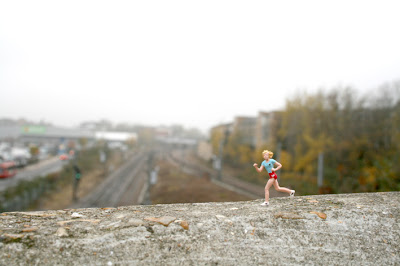What makes a place fun?
Scale seems to have something to do with it.
As any SimCity player can tell you, part of what makes that game fun is playing a powerful being that can dink with a giant city. It's fun to feel big, or at least, it's fun to look at tiny things.
London-based slinkachu creates tiny urban tableaux from miniature figures placed in satirical and surprising settings. You might find police investigating a drowning victim in a puddle, or thrill-seekers riding a real snail. Pictures of the tiny people close up and then from a pedestrian point of view makes clear the exaggerations in scale and through these contrasts the comedy works.
San Francisco-based artist Krista Peel has created a large number of doll house-inspired miniature art projects. Her 2009 calendar project,
Public Park provided a 52" x 30" HO scale park and invited fellow artists to create scenes to place in the park. The Candy Land-colored scenes combine miniature whimsy with a landscape that seems real enough that you find yourself wishing that it was.
What's the critical place of scale in fun? These projects suggest a few answers–surprising juxtaposition, childlike wonder at toy-sized objects, unexpected collisions of naive and serious content and, well, there's just something magical about tiny pretend people.

Posted by email from buzzcut blog (posterous)




